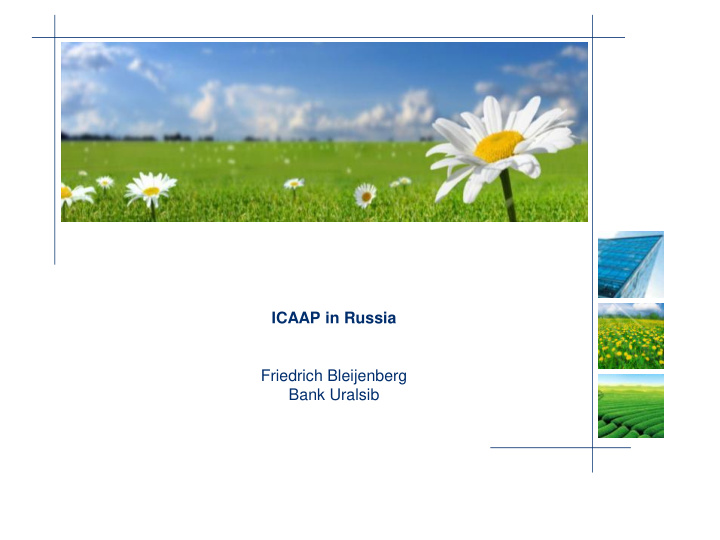



ICAAP in Russia Friedrich Bleijenberg Bank Uralsib
The agenda enda ICAAP in Europe – a short history The lessons from Europe and the time for Russia Capital for ICAAP – the choices Famous last words 2
Europe, ope, Basel el implem ement entati ation on and the 2008 8 crisis European regulators focused differently on ICAAP…. But the 2008 crisis still happened… UK: Principle based ICAAP Germany: Rule based MARISK 3
Too little e too late Pillar 1 Pillar 2 Pillar 2 Pillar 1 IRB ICAAP AMA ICAAP IRB SREP MA SREP 2001 2012 2007 2008 2010 2015 Basel II Basel III Liquidity Crisis 192-T 483-P 96-T 3624-U 4
A good d time for lessons ons learned ned • Governance – make sure you have a proper governance framework to manage risks, capital, business and models • Documentation – key is to document processes policies and procedures properly within the ICAAP framework • Economic Capital – alignment of ICAAP and ECAP is key, only by being able to show that the quantitative methods you use are also really used in business decision taking can you convince a regulator that your methodology makes sense • Data – modelling is important, but if the data is not correct your models won’t work • Stress testing – Don’t overdo it…. Keep close to reality and to your business 5
Universal ersal gover ernanc nance e structur ture Supervisory Board Audit Committee Compensation Committee Senior Risk Committee Management Enterprise Risk Compliance Credit Committee ALCO Committee Committee Governance is key Basel defines 13 principles around governance Key items: • Delegation of authority • Independence of risk management • Role of the supervisory board • 3 lines of defence 6
Methodol odology ogy is key Strategies Policies Methodologies Documentation of ICAAP – be aware of the piles 7
Basel el and ICAAP AP capi pital tal Pillar 1: Quantitative Pillar 2: Assessment approaches to capital approaches Credit IRB (F/A): Use of Pillar 1 models ‘Own’ approaches to Models Operational AMA: assessment Models Economic Capital Market MA: Models IRRBB Liquidity Other Risks Stress testing 8
Regulator ators want clear ar capital tal to cover er risks Regulatory capital based on Pillar 1 calculations and Pillar 2 additions But models need to have a proper use-test 3624-U about Capital: •Current capital needs and planned capital •Limit system •Capital adequacy assessment •Stress testing for all significant risks •The risk management methodologies chosen should be either following CBR rules or be part of ‘international best practices’ 9
But what does the boardroom want…. Economic Capital! I need to understand my capital needs to run my business optimally! 10
How to merge e the views ws Economic Capital: - Use test by business use - Based on quantitative methods - Focus on Credit and Market risk - Lifecycle expected loss Using your Economic Capital models under Pillar 2 is a good option, but they have to be broadly Basel compliant Regulatory Capital: - Use test needs proof - Based on quantitative methods for Pillar 1 risks - Annual expected loss - SREP as control mechanism 11
How does my capi pital tal look One aim is to reduce the “supervisory multiplier” by demonstrating to the regulator that the process for assessing overall capital adequacy is robust and credible by fulfilling all SREP requirements Supervisory multiplier • Sufficient capital to support/fund strategy SREP Score >4 Methodology for ICAAP Organization • Quality and use of capital managing capital • Assessing ICAAP quality • Adoption (testing, use) and challenge SREP Score 3-4 (internal audit, external review) • Peer group analysis Risk Management & ICAAP results • Disclosure mechanisms Capital SREP score 2-3 • SREP Measurement versus 3050-P CHALLENGES • Modelling of capital plan with/without management actions • Alignment of risk and finance data, Capital planning & stress testing systems and processes Pillar 2 • Diversification BASE CAPITAL • Methodology robustness of non Pillar 1 risks • Treatment of non-quantifiable risks Pillar 2 risk Pillar 2 controls • Choice of stress tests (mild versus severe) and testing consistency Minimum capital Credit risk Credit risk controls • Review of Pillar 1 numbers and Pillar 1 Operational risk methodologies Operational risk controls • Meeting operational risk criteria for TSA/ASA Market risk Market risk controls Low Medium High Level of Capital to be held It is crucial that firms are fully confident with their ICAAP and that it is embedded throughout the business, from board level adoption to operational implementation! 12
But ICAAP AP is more than n just t capi pital tal The regulator doesn’t know all. We need to teach our regulators about ourselves. Regulators and auditors change often, so every time we might be tested and audited by a different leader or team. The key is that as a bank you tell a consistent story. The ICAAP process, and with that key documents like Risk strategy and ICAAP document are there to help you to tell this story. Tools around document management, a proper governance process around review and approval will further establish the level of maturity around ICAAP. But the key is, not to act purely on what is written in Basel and CBR documents. The key is to act in the boardroom, to challenge what is presented and to want to understand what risks are there in the bank and to comprehend the consequences of strategic decision. 13
Recommend
More recommend